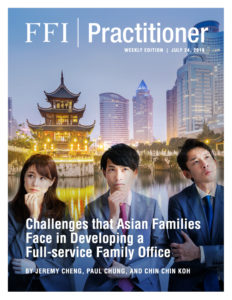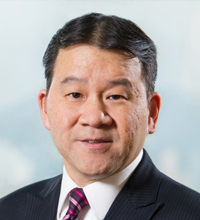
View this edition in our enhanced digital edition format with supporting visual insight and information.
This week’s FFI Practitioner edition continues our series of articles written by members of the Editorial Committee. Thank you to Paul Chung, Jeremy Cheng, and Chin Chin Koh for this article examining the challenges confronting Asian families interested in establishing a single family office as well as practical advice for advisors navigating these family office challenges around the world.
There has been a proliferation of single family offices (SFOs) in Asia in the last decade, with a large increase with nouveau wealth in China, and other emerging markets in the region as second- and third-generation wealth are being transferred. Yet, Asian families’ appreciation of the family office appear more to be a private investment arm than an SFO. Many of such family offices focus on investments, coupled with opportunities in the region earning Asian family offices the highest average portfolio return of 16.4% in 2017, compared with the global average of 15.5%.1
Compare this against those in the West, where families set up SFOs primarily as one-stop shop, from wealth management and investments, philanthropic giving, tax planning through to trust and estate planning. They also utilize the governance, education, social, and administrative functions of the SFOs. However, this same full-service model has yet to unfold in Asia. The question: if a full-service SFO is beneficial to an Asian family of wealth, and why has the evolution of such SFOs been slow in Asia?
As practitioners in Asia working in this area specializing in family office advisory, we share two brief cases2 from the region to offer some insights into answering this question.
Jerome Lee: Founder of an embedded family office in Hong Kong
Jerome successfully built up a business empire from scratch. He set up a family office, which was well-embedded into the existing business operations he oversaw. Everything ran well and was managed with a team of professionals. Jerome has four children from two marriages. The elder two children are married with children of their own. The younger two are still in college and university and have recently moved out of the family home. Everyone in the family gets along well, but none of his children are interested in taking over his business or the leadership role in the family. The elder two children look set to pursue their own careers in law and medicine. The younger ones from his second marriage grew up in a life of wealth and ease, and in his view, they do not have what it takes to succeed him.
Looking ahead, Jerome was sure he could retire comfortably and provide for his children and grandchildren. But he was unsure about the state of his business and his personal investments after he is retired or no longer able to be actively involved in managing these. He was uncertain whether he could entrust his professional managers to manage all these for the family and was also hesitant about leading the difficult discussion of succession with his four children.
Patrick Tan: Rising-generation steering a formal family office in Singapore
This was Patrick’s fifth meeting with his lawyer who helped to draft his family constitution after a few conversations with him last year. Patrick was becoming frustrated and taken aback by the unwillingness of his younger siblings to sign off on the document, even though their father was in full support of the idea. As a third-generation member, Patrick found having a family constitution to be an essential tool in governing his increasingly diverse family with a holding company with wide-ranging interests from an oil palm plantation to different property businesses all over Asia.
He first learned about the concept of a family office during a class at his university and was fascinated by its use to pool the financial, social, and human capital of the family. After taking some time to convince his father, Patrick launched a single family office to manage his family assets in 2015, and since then, the family office has gradually become another “family business.” He was envisioning that in 10 years’ time, his family office could open up to serve members from other branches of the family, but currently, his vision appears to be stalled.
The 3Ls barring the evolution of full-service SFOs in Asia
While every family office has its unique history and development trajectory, these two cases reveal three common challenges that we observe in the maturation of various Asian family offices. These challenges are not uncommon, and can be applied globally as fundamentals of how to manage the family office:
- Lack of trust: It is not uncommon to see patriarchs like Jerome failing to recognise that the rising generation is equally capable as a trailblazer and able to accomplish great achievements. The issue of intergenerational trust is heightened in hierarchical families in Asia, where some patriarchs choose to hold on to the control of their wealth until the very last minute. Instead of using the family office as a vehicle of succession planning, its sustainability becomes a matter of concern when the patriarchs get old, particularly when there is a lack of trust amongst sibling or cousin teams. As in Patrick’s case, his siblings were unable to see the constitution as a fair tool for all family members, reducing chances that the family office can leverage it for governance. The trust issue can be either cultural or part of a natural evolution in the family’s journey that takes a deliberate and concerted effort to work through. It usually starts with an awareness that this lack of trust is hampering any real progress in the family.
- Lack of professional support and resources within family offices: Jerome’s concern of whether to entrust non-family executives to manage his family wealth is quite common in Asian family offices. There is a tendency for Asian families to avoid centralizing sensitive information and engaging an outsider to manage family matters. At times, even when the family is willing to seek external help, professional advice tailored for the family is rare. In Patrick’s case, the lawyer drafted the constitution without engaging all key stakeholders – Patrick was consulted, but not the others in the family. It was obvious the document was created from a generic template, and the family did not go through the discussion process, which is much more important than the constitution document itself. A lack of professional support and resources to launch a wider set of functions can result in keeping Asian family offices at their infancy stage.
- Lack of vision, mission, and institution for family offices: Many Asian families equate investment offices with family offices. Most Asians assume that the family office is for managing the family’s investments. Few are like Patrick or other Western families such as the Gates, Rockefellers, and Rothschilds, who also consider preserving family social and human capital through their family offices. Hence, not many Asian families are able to institutionalize their family offices to achieve this bigger vision. The importance of attaining measurable investment returns at times masks the need of family offices to invest in less tangible outcomes such as governance and building soft skills, which are fundamental pillars to maintaining harmony and unity of enduring families.
As a result, the majority of Asian family offices are more focused on helping the family grow its financial investments and not thinking or working broadly enough to develop the other critical functions, such as governance, setting the long-term goals and vision of the family, or other initiatives to strengthen the family legacy. In the long run, the objective of the family office becomes limited to only growing the wealth. While this is a key component of the family office, families that are solely focused on managing wealth through the family office then lack clarity and direction in dealing with the bigger question of the purpose of that wealth – be it for the benefit to society or to expand the family business.
Journey to a more vibrant family office
These 3Ls may appear daunting, but there are two good practices that families may consider. The basis is to initiate the process of nurturing trust and communication within the family and beyond, and help them plan for a shared vision so they can begin their journey to establishing a more vibrant family office:
- One imperative is developing a habit of doing simple things together as a family. This can be for Sunday lunch or celebration of festivals, birthdays, births, or marriages. Families that meet together stay together, and this is how communication and trust are nurtured. These family meetings can build collective memories and affirm achievements of family members without becoming competitions of who has done better.
- The second practice is holding family retreats with planned goals and agendas. Families that succeed make it a point to meet on a regular basis (e.g., annually or bi-annually) to learn, grow, and have fun together. These intentional retreats must be fun so that members will want to attend every time. Professionals or advisors can be engaged to help identify planning issues of interest to the family and to facilitate constructive dialogues at these retreats. The buy-in of all family stakeholders in the process reinforces positive team dynamics, laying the ground to build trust and communication for the entire family. This allows family members to have interactions and functions apart from only wealth management, engaging them toward different visions and goals opening up the family’s perspectives and opportunities.
Evolution, not revolution
The benefits of a full-service family office are exponential. However, generational transitions require fundamental changes in the ways that family members associate with one another, and how a family and their assets should be managed and governed. The growing diversity in family calls for an evolution of greater functionality of family offices – that advisors encourage and support. Cultural differences can bar the evolution of the model in Asia, and possibly hinder a clear articulation of vision and missions of different Asian family offices. It comes down to how families see value in having professionals help them to identify and achieve their long-term goals, and to build the trust that the centralized information will not be at risk or be ill managed.
There are a few roles that family office advisors can offer to support and assist families in navigating through the uncharted waters, and creating success in this evolution:
- Guide families to (re)think why they should stay together and build their family office with the ultimate goals and vision in mind.
- Widen the family’s perspective to cover both financial and non-financial goals of a family office.
- Help families fill the gap between where they are now and where they want to go by planning. The rule of thumb is “form follows function.”
- Steer education and training needs of the family in the process.
- Most importantly, help families see all these changes as an evolution not revolution.
1UBS & Campden Research (2018). The Global Family Office Report 2018.
2All client identifying data in the cases have been removed, names and facts are masked and any similarity or resemblance to any person, is purely coincidental.
About the Contributor

Jeremy Cheng, ACFBA, ACFWA, is Center Manager of the Tanoto Center for Asian Family Business and Entrepreneurship Studies at HKUST. He is Chair of the FFI Asian Circle, and a faculty member for GEN 501: Myths, Realities, and Trends in the Field of Family Enterprise. Jeremy can be reached at [email protected]

Paul Chung, CFBA, CFWA, and has more than 25 years of Wealth and Asset Management experience serving families, family office, and family enterprises as a trusted wealth and business advisor. He enjoys helping families build and extend their legacies across generations. A member of the FFI Practitioner editorial committee, Paul can be reached at [email protected].

Chin Chin Koh, LLB (Hons), CFWA, is a qualified lawyer and has been advising family businesses and entrepreneurs on issues relating to family office, private banking and family governance since 2005. Before that, Chin Chin was a lawyer in private practice. She is currently based in the EY member firm office in Singapore and advises individual clients and business families across Asia-Pacific on topics such as succession and legacy, family governance, asset-holding and structuring, family office design and set-up. Chin Chin can be reached at [email protected].
About the Tanoto Center for Asian Family Business and Entrepreneurship Studies at HKUST
The Tanoto Center for Asian Family Business and Entrepreneurship Studies is a leading research center in the burgeoning field of Asian family business and entrepreneurship studies, bridging the knowledge gap between academics, practitioners and policymakers in all of its programs and activities. The Center focuses on ethnic Chinese family businesses as a dynamic and influential network contributing to the world’s economy.
About JVSakk Asset Management Ltd.
JVSakk Asset Management Ltd. is a group based in Hong Kong specializing in consulting individuals, families, and businesses on their family wealth and business needs.
About EY Singapore
EY Corporate Advisors Pte Ltd has a 129-year history and is part of an integrated Asia-Pacific Area, which comprises more than 40,000 people in 22 countries.
The views in this article are those of the author and do not necessarily reflect the views of the global EY organization or its member firms.

View this edition in our enhanced digital edition format with supporting visual insight and information.





